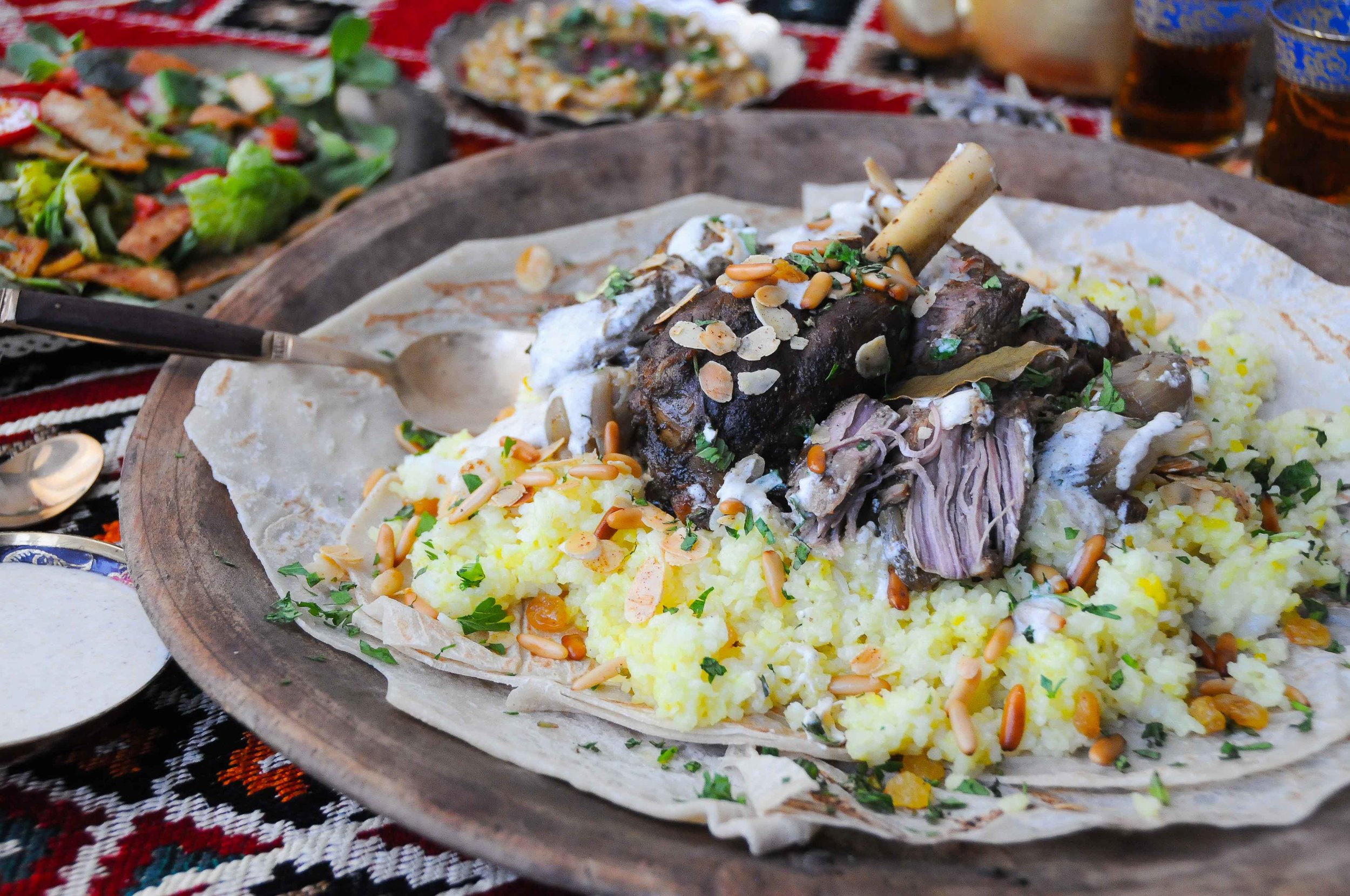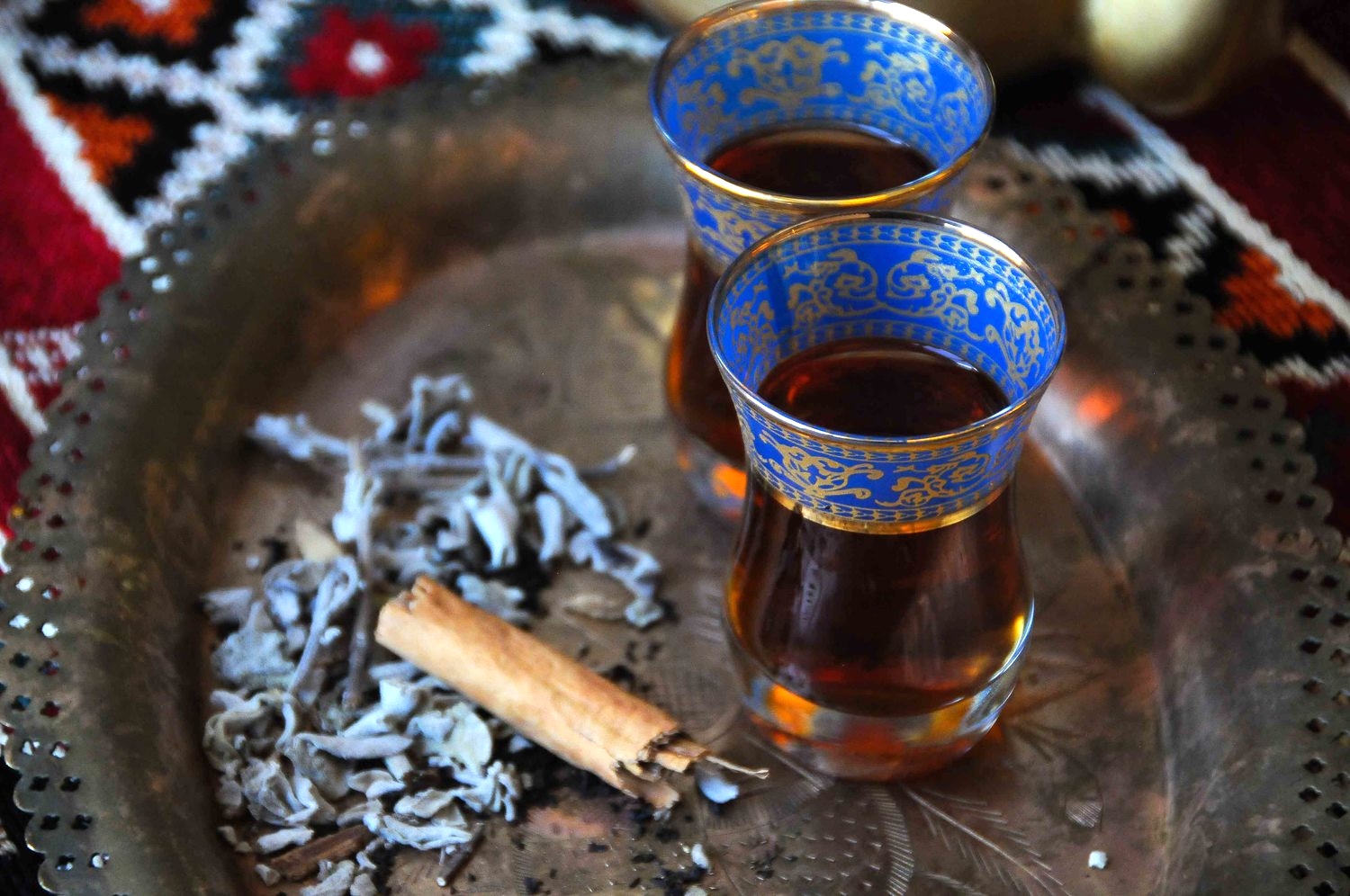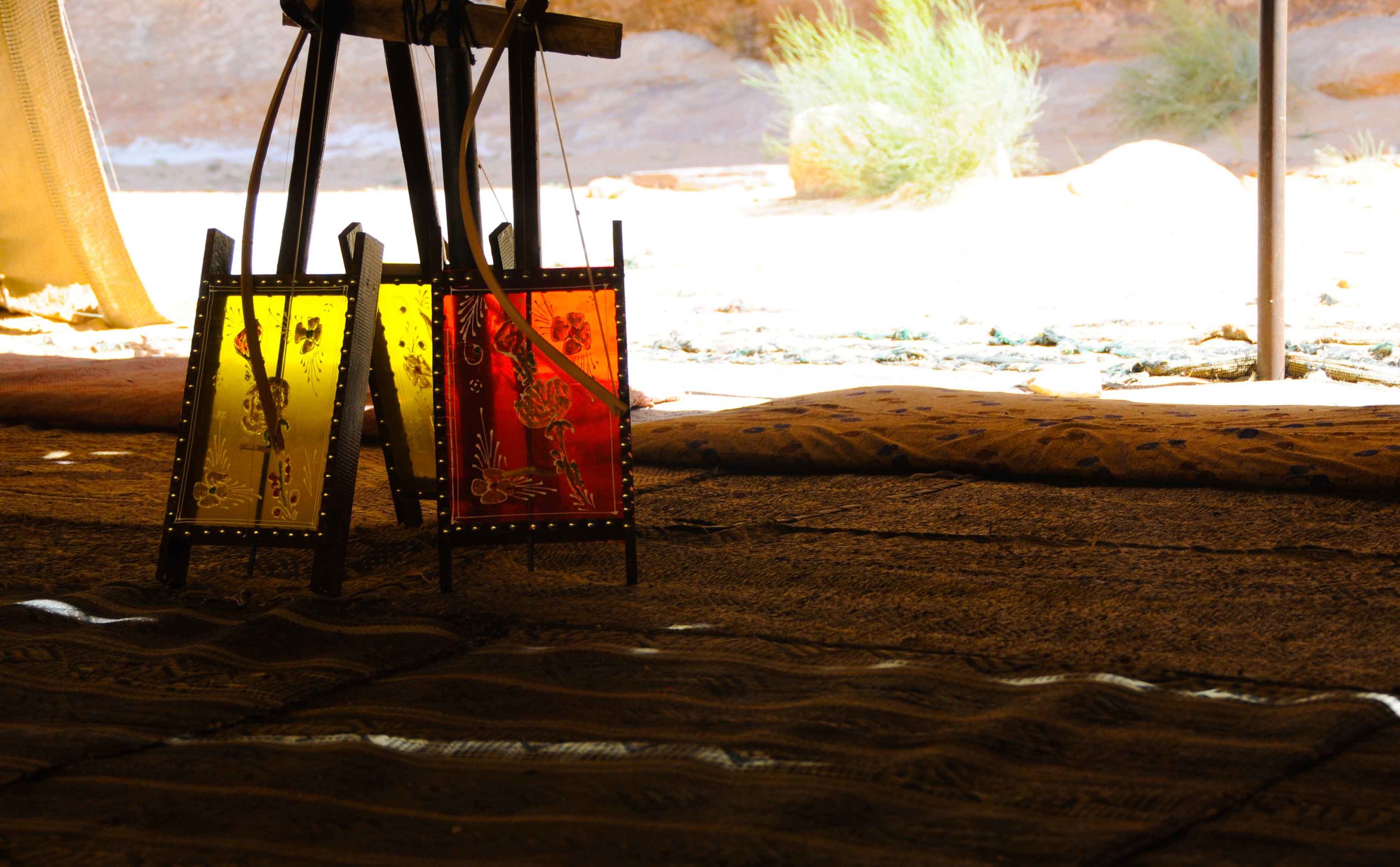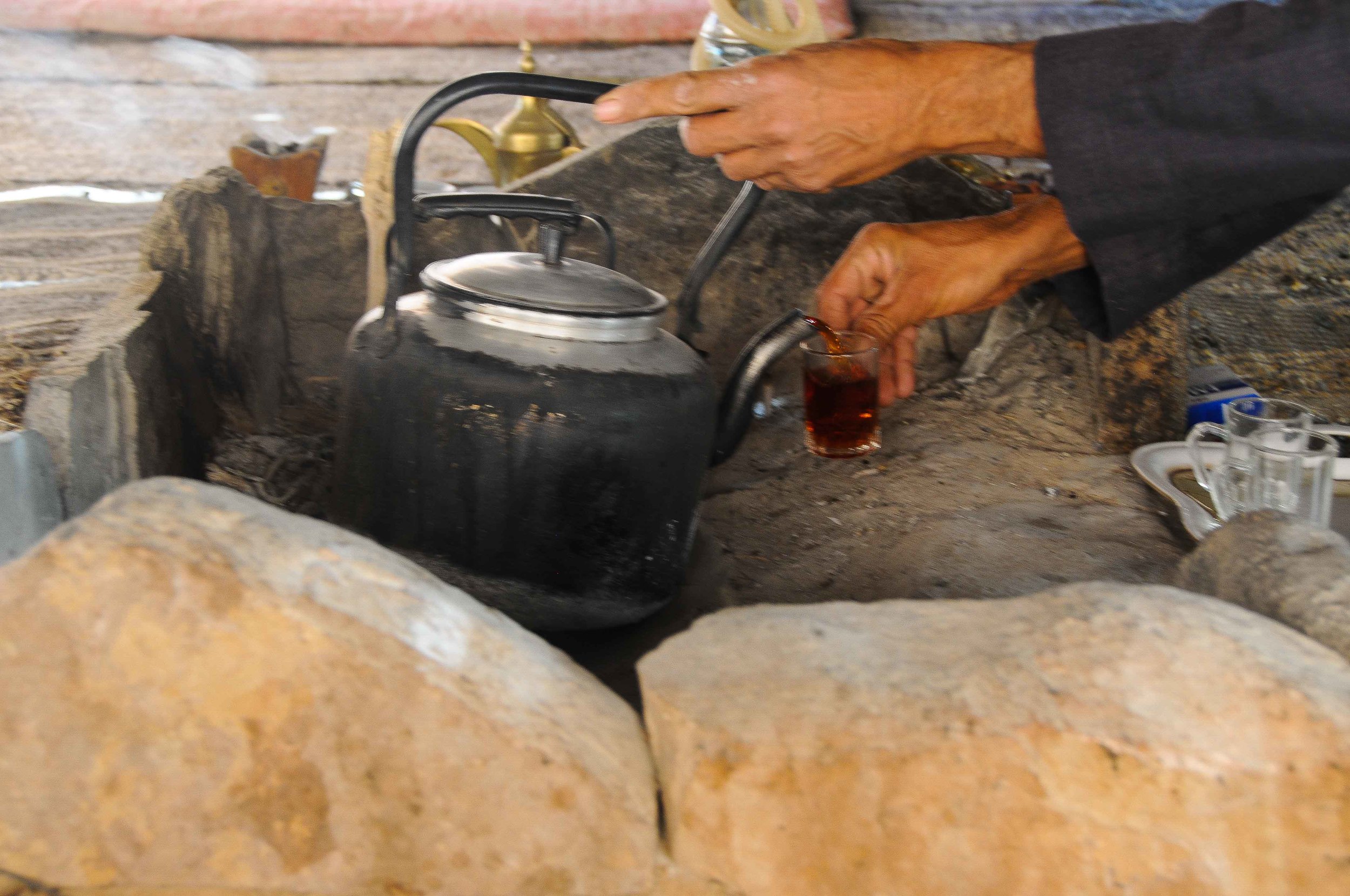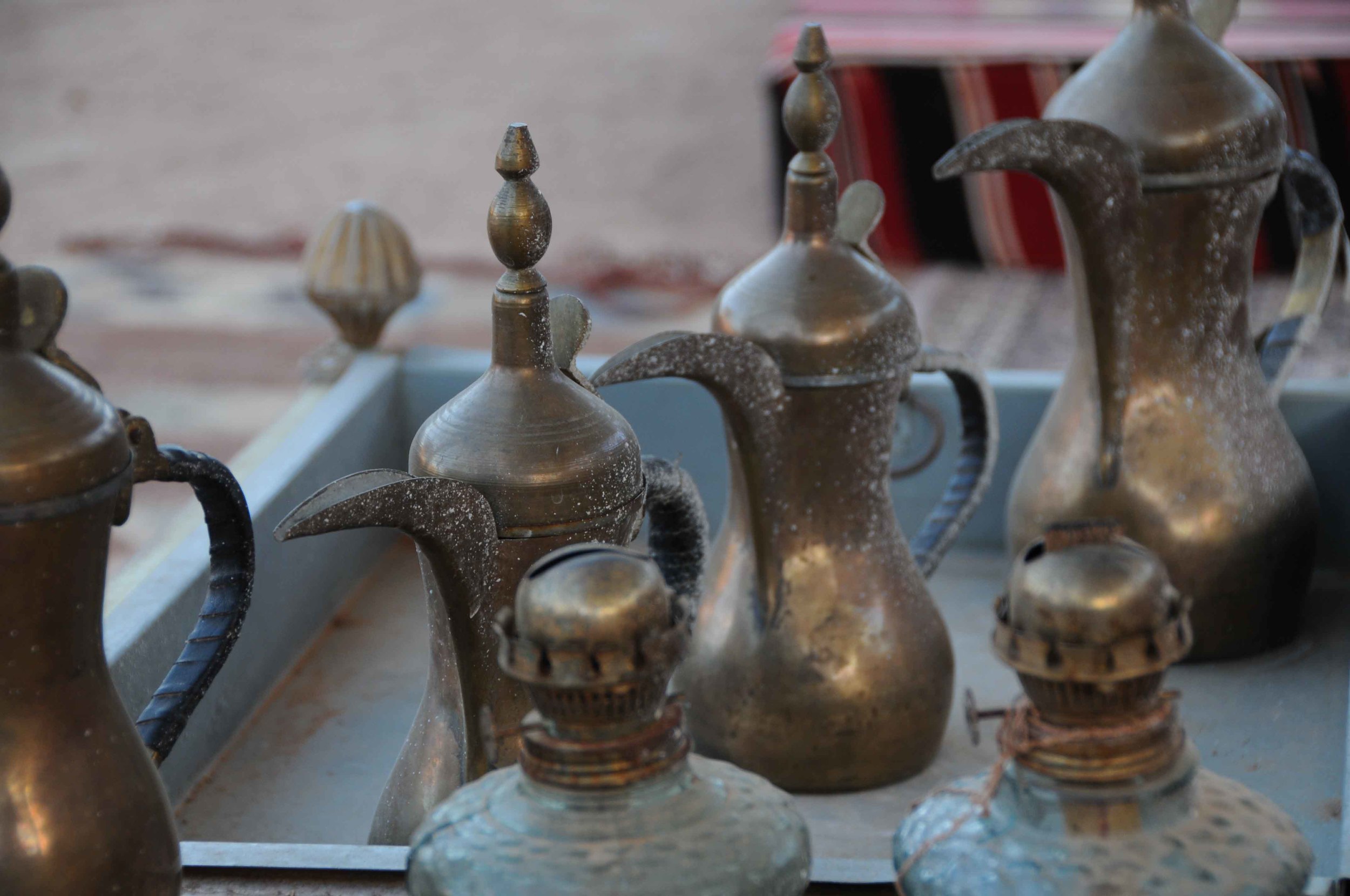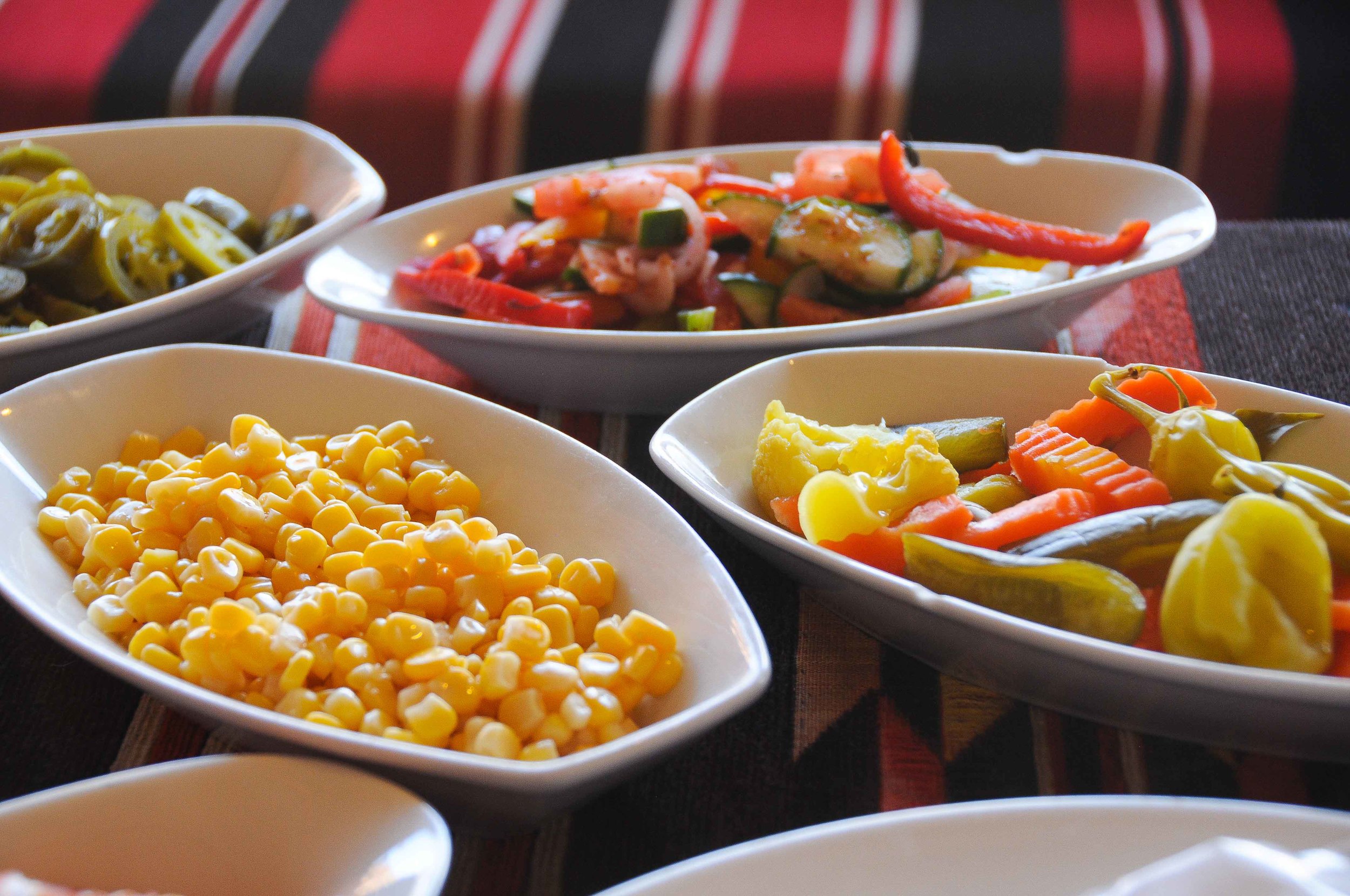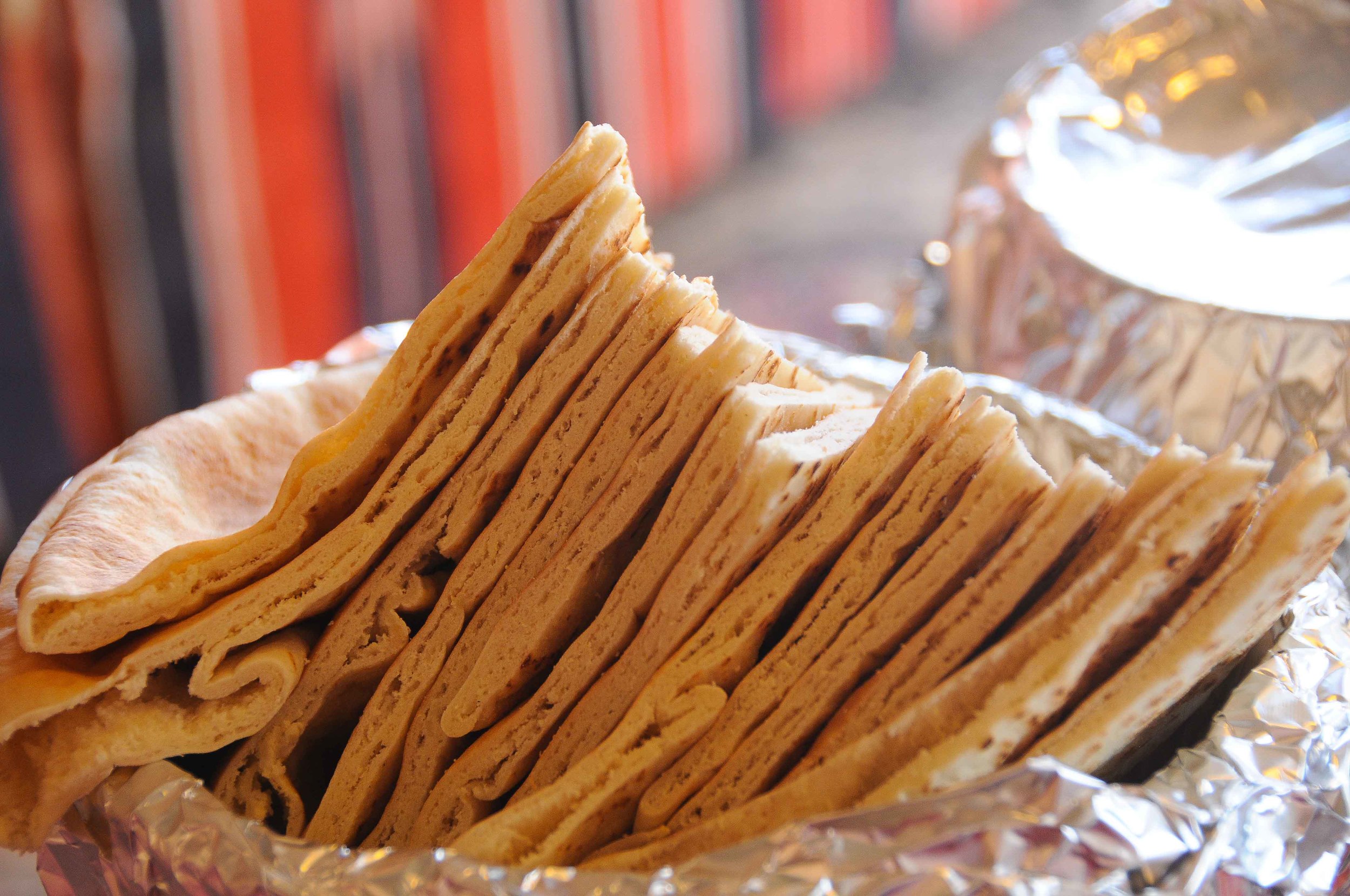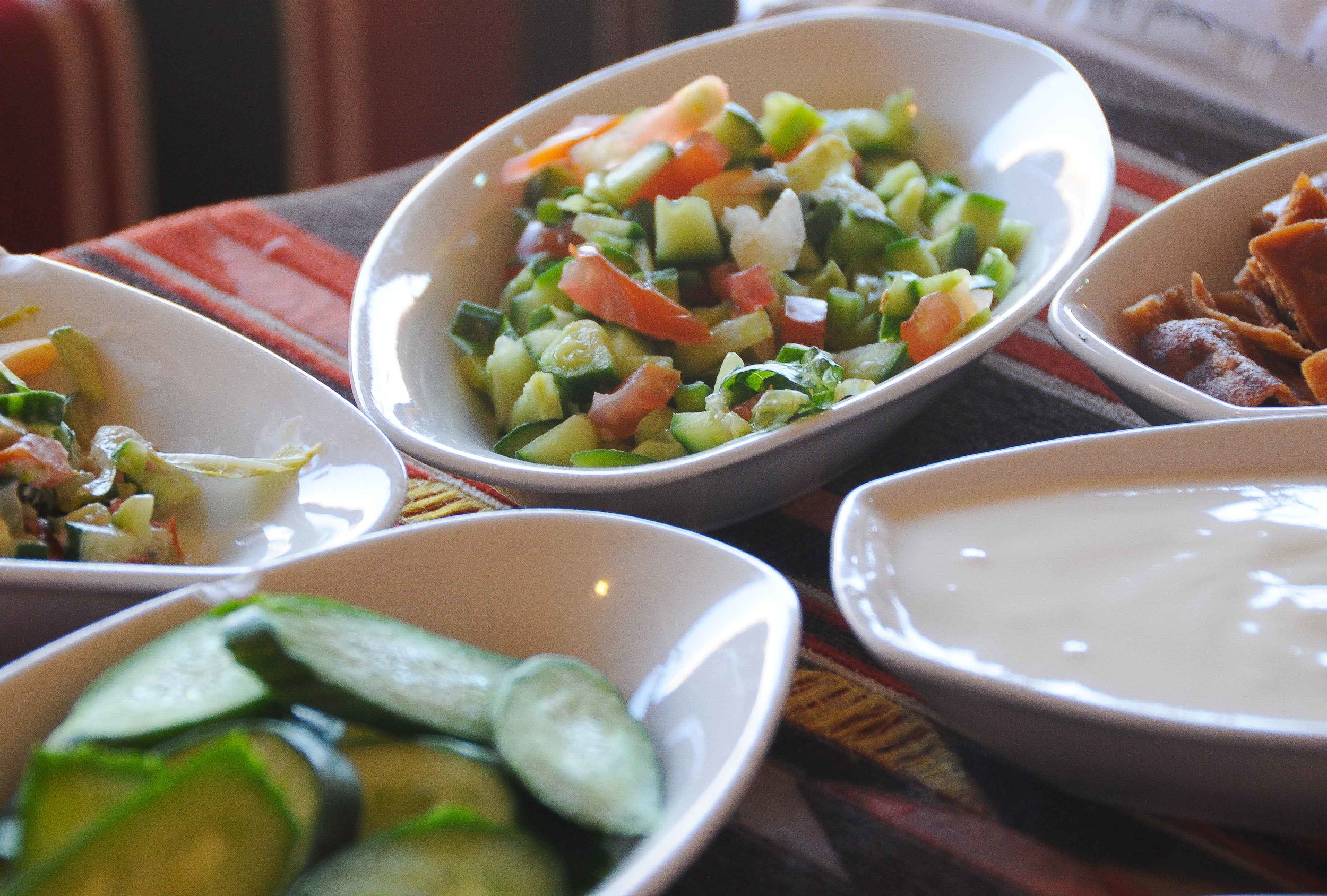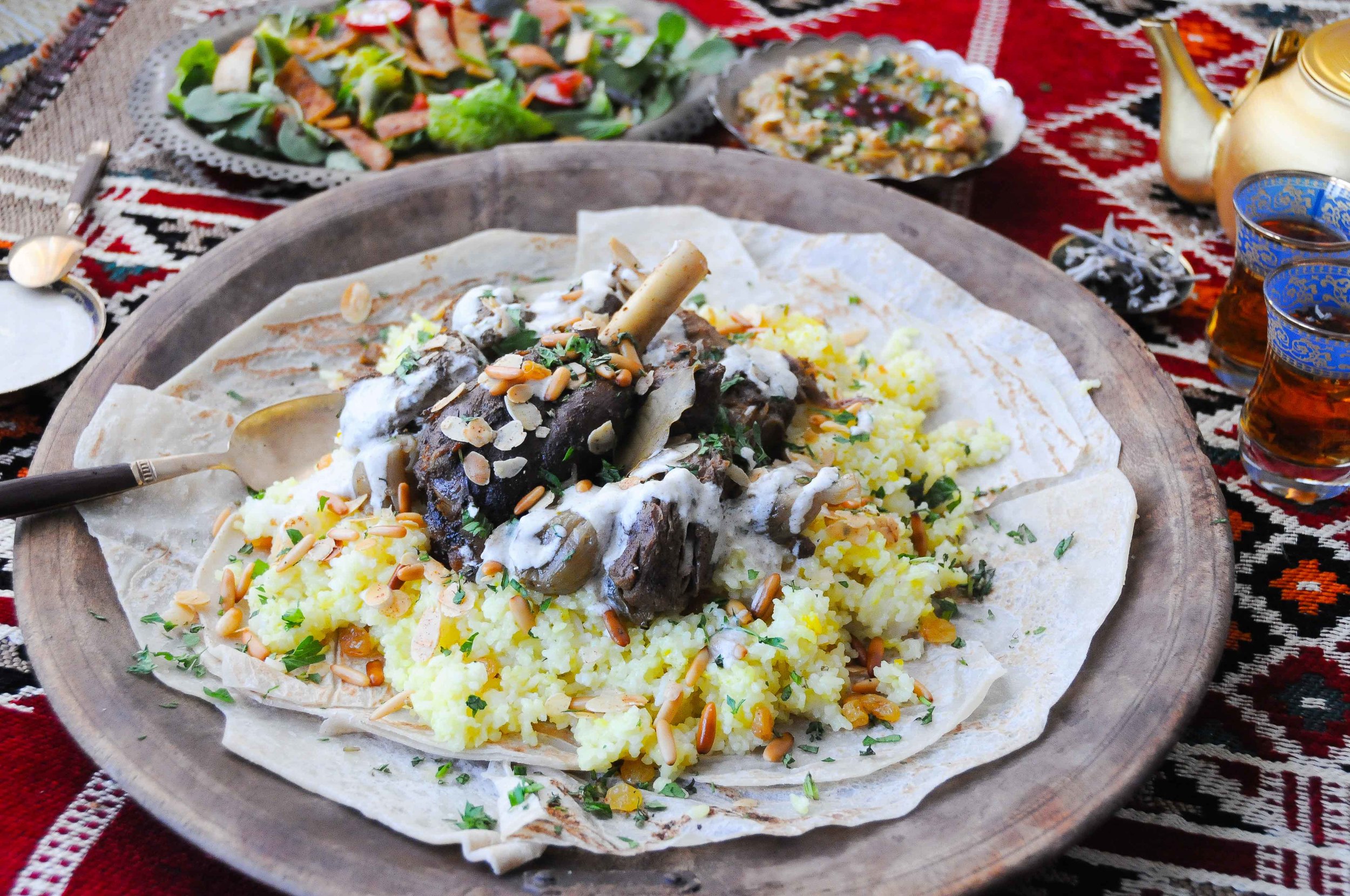Shadows are short in the noon-day desert sun, and the horizon thick with heat. In the distance, always just-out-of-reach lagoons emerge and evaporate in a mirage of blues, slivers, and even purple. Many millennia ago, the desert valley of Wadi Rum was not a valley at all, but a cayon-ed seafloor covered by leagues of water. The water is no longer, but I suspect little else has changed. The silence is as thick as water, and the heat as heavy. All around, stillness, immutability – a landscape seemingly unmarked by the passage of time…
But if you look a little more closely, there are markers to be found. Rudimentary figures and inscriptions etched in the rock, and tiny wells scooped out on low ground to collect the rare rains. What appears, to the untrained eye, an empty wilderness, is actually an important caravan route, much traversed in the day by Arabian traders on their way to Asia, and in use still today, by the nomadic Bedouin tribes of Jordan’s South.
The Beduion tent settlements are difficult to pick out in the vast and spartan landscape, but cross their threshold, swapping baking sand underfoot for cushion-strewn carpets, and be transported to a place of surprising comfort and hospitality in amongst the most inhospitable surrounds…
Inside, under a pitched roof of canvas, a low fire crackles in a pit of sand, filing the air with a soft mist of smoke. On top of the fire, a brew of wild sage tea perpetually simmers in the kettle, on hand to welcome unexpected guests. Refills are offered over and over, but custom has it that it is only acceptable to refuse after the third. Such is the Bedouin hospitality – there is no rush in the desert, and you can stay the length of three teas, surely.
In a corner of the shaded tent, a ‘refrigerator’ in the form of a large clay urn, half buried in the sand keeps water surprisingly cool, and, for entertainment, traditional song, murmured in tune with melodies plucked from an instrument of horsehair and sheep skin.
When food is served it is always plentiful, the array and variety of small plates astounding. A selection of pickles, numerous salads, hummus, mutabal, baba ganoush, yogurt, flat breads, curried vegetables and potatoes, all this before the piece de résistance, a spiced roast of lamb and chicken slow-cooked in a pit beneath the hot sands, and served with mounds of saffron rice.
Come sunset, emerge and you will find the desert transformed. Long shadows now track across the same sands that shimmered only moments before with a lie of mirage and haze.
The colour plate cycles rapidly in the dying moments of the day – through deep-yellows, oranges, and pink, with a dusty darkness reigning only briefly, before a more encompassing, and calming blackness settles, its cosmic depths perforated only by the pin-hole-like stars….
Baba Ganoush
The array of traditional Jordanian mezze offerings is too wide to include a recipe for each, so I’ve decided to concentrate on only my very favourite. While, in the West, ‘baba ganoush’ usually refers to a blended smoky paste of aubergines, I’ve found that in the Middle East, this name refers to an almost salad-like dish of grilled aubergines flavoured with freshly chopped vegetables, herbs, and pomegranate molasses instead. The blended smoky paste on the other hand, also commonly available, is called 'mutabal.' I have no idea from where this confusion specially arose, but am very clear on which of these two different dishes I prefer…
The only remaining difference to resolve then, is whether you choose to grill your aubergines, or cook these directly over a gas flame. There are some who swear that flavour will only ever be right over a flame, but as the current (unhappy) owner of an electric cooktop, I have been unable to put this definitively to the test. What I will say though is, speaking as a person qualified by having consumed ridiculous quantities of baba ganoush, the version below did not seem to suffer at all from relying on aubergines blackened under a grill.
Ingredients
(Serves 6)
- 2kg (approx. 5) large aubergines (eggplant)
- 1 shallot – finely chopped
- 1 small green pepper (capsicum) – finely chopped
- 125g cherry tomatoes – finely chopped
- 3 teaspoons pomegranate molasses
- 6-8 tablespoons extra virgin olive oil
- 1 lemon – juice only
- Sea salt & freshly ground black pepper
- Small handful of walnuts – shelled & chopped
- Small bunch of parsley – finely chopped
- Small bunch of mint – finely chopped
- Handful of pomegranate seeds – to garnish
Lightly score the aubergines using the point of a sharp knife and place under a hot grill, or over a gas flame until blackened. Turn the aubergines while roasting using a pair of metal tongs to ensure they cook on all sides. Under the grill the aubergines should have blackened and become soft after approximately 1 hour, over a flame it will only take 15-20 mins.
When cooked, remove the aubergines to a bowl, cover, and set aside until cool enough to handle.
When cool, peel the charred skin from the aubergines using your hands. Next, proceed to tear the flesh of the peeled aubergines into lengthways strips. Discard any larger clumps of seeds that you come across in the process, but don’t be too concerned to pick out every single seed, it’s not a problem if some of these make it into the finished dish.
Now, place the strips of aubergine in a sieve positioned over a large bowl and leave to drain at room temperature for at least one hour (or more if possible). The more water that is allowed to drain from the aubergine now, the more flavoursome it will be later.
Once the aubergine has drained, place in a clean bowl and add the finely chopped shallot, green pepper, and cherry tomatoes, along with the pomegranate molasses and extra virgin olive oil. Exactly how much olive oil you wish to add is a matter of taste, but do add enough such that the dip obtains a loose-ish texture. Now is also the time to season using a fairly generous amount of salt and freshly ground black pepper.
Mash a little with the back of a fork as you mix to combine the ingredients, and then set aside at room temperature once again for another hour to allow the flavours to develop.
To finish the baba ganoush, add the juice of one lemon, and stir this through, before spooning the dip into a serving bowl.
Using the back of a spoon, swirl to create a hollow in the centre of the dip. Scatter the finely chopped mint and parsley, along with the chopped walnuts around the edge of this and place some pomegranate seeds into the centre. Drizzle a little extra olive oil over the pomegranate and serve with warm pita bread.
Jordanian Mansaf
A dish of lamb slow-cooked in a yogurt sauce – mention Mansaf to any Jordanian and you’ll instantly have a dinner invite, as well as a long and detailed conversation regarding cooking methods on your hands! Like all national dishes, everyone has their own opinion on exactly how it should be, and will guarantee you that only their mother/aunt/home town knows the correct way to make it…
Traditionally served at events such as weddings, and to celebrate Eid at the end of Ramadan, Mansaf is always made to serve a crowd (so much so that a number of recipes you come across will denote portions in terms of the number of lamb carcasses required!), and is assembled on giant platters with sherak (Arabic flat bread) forming a base, topped by rice and meat.
Though I’ve stayed true to the traditional presentation in this recipe, I have substituted one of the traditionally important ingredients – jamid, the dried fermented balls of goat’s yogurt that are usually re-hydrated to form the basis of the Mansaf cooking sauce. The problem is, not only are jamid balls exceedingly difficult to find, even here in the Middle East, but they are also, it is fair to say, a bit of an acquired taste. For the travelling Bedouins, the ability to ferment and preserve yogurt in this way was no doubt invaluable, but for those of us who have access to the fresh stuff courtesy of the supermarket, the absence of need for fermentation might be thought of as an altogether fortunate thing!
A few other Westernisations also snuck into my recipe along the way – I’ve opted to marinate the meat in yogurt first, for instance, (as opposed to cooking the meat in it), then add a yogurt sauce at the end, so an ‘authentic’ recipe it’s not. Nonetheless, the sprit of the dish perseveres – slow cooked lamb, meltingly tender, served atop masses of soft, buttery rice, with a rich spiced topping of yogurt. And be sure not to skip the very traditional toasted pine nuts and flaked almonds scattered over at the end – they are almost the best bit!
Ingredients
(Serves 6)
- 2.5 kg total weight lamb pieces (shoulder with bone-in, and 6 shanks) – have your butcher cut the lamb shoulder into approximately 6 evenly sized pieces.
- ½ teaspoon ground turmeric
- ½ teaspoon ground cinnamon
- ¼ teaspoon whole cloves
- ½ teaspoon cumin seeds
- 2 teaspoons cardamom pods
- 2 tablespoons baharat spice
- 500ml natural yogurt
- Juice of two lemons
- Approx. ½ cup light olive oil
- 20g butter
- 200g pearl onions – skin removed
- 3 bay leaves
- Sea salt & freshly ground black pepper
- ½ cup sliced slivered almonds
- ½ cup of pine nuts
- ½ cup of parsley – finely chopped
For the rice
- 3 cups medium grain rice
- 50g butter
- ½ teaspoon ground turmeric
- ½ cup golden sultanas
- 4½ cups water
To serve
- 4 slices of sherak (thin Arabic bread)
Baharat spice is a blend including allspice, cinnamon, cassia, coriander, cloves, and cardamon (amongst other things) and can be found in Middle Eastern supermarkets.
The lamb needs to marinate overnight, so start this dish the day before you intend to serve.
To make the marinade for the lamb, split the cardamom pods, one by one, and scrape the seeds into a mortar and pestle, discarding the empty pods. Add the cumin seeds and cloves to the mortar and grind to a fine powder.
In a large bowl, combine the ground spices from the mortar with the ground turmeric, cinnamon, and baharat spice. Add 200ml only of the yogurt to the spices, along with the juice of one lemon, some salt, and a generous grind of black pepper.
Mix with a spoon to combine the ingredients, before introducing the lamb shoulder and shanks to the bowl. Turn each piece to thoroughly coat in marinade, before removing to a large Tupperware container or zip lock bag. Scrape any excess marinade left in the bowl into the container and seal before placing in the refrigerator to marinate overnight.
When you are ready to cook the lamb, remove it from the fridge and preheat the oven to 160°C.
Before being left to slow cook in the oven, the lamb needs to be sealed over a high-heat. To do this, warm 3 tablespoons of light olive oil, together with 20g of butter in a large heavy-based casserole, and place over a high heat on the stove-top.
When the butter has melted and the oil is hot, fry the lamb pieces quickly, in small batches, turning with a pair of metal tongs until they are seared on all sides. A few minutes in the pan is all it will take to properly seal each piece of lamb.
Arrange the browned lamb pieces in a large roasting tray along with the peeled pearl onions and 3 bay leaves.
Next, swish 500ml of water through the marinade container, in order to mix as much of this as possible with the water, and then pour over the lamb and onions in the roasting tray.
Cover the tray with foil, and place in the oven to cook slowly over 3-4 hours. During the cooking time, check the lamb at half hour intervals, turning each piece over, and checking liquid levels. If the lamb looks as though it is drying out at any point, add up to 150ml more water.
Once the lamb has been the oven for approximately 2 hours, begin to prepare the rice by washing it several times in a sieve, before leaving to soak in plenty of water for 30 minutes. This will remove excess starch and ensure that the rice does not become sticky when cooked.
Meanwhile prepare to toast the almonds and pine nuts by heating just under half a cup of light olive oil over medium heat in a small frying pan. Fry the almonds first, then the pine nuts, removing these to drain on paper towel when golden using a fine frying sieve. Put the nuts aside to use later as a garnish, and retain the oil to use in cooking the rice.
When the lamb has been in the over for 3 hours, and has visibly softened, beginning to break apart, prepare to cook the rice by heating 50g of butter along with the oil that you fried the nuts in, together in a large saucepan.
Drain the rice, and add this, along with half a teaspoon ground of turmeric and the golden sultanas to the saucepan. Stir briefly combine the rice and sultanas with the spice and oil, before adding 4½ cups water, and placing a tight lid on the saucepan.
Bring the rice to a boil over medium heat, before turning the heat to a simmer and cooking slowly.
After 30 minutes, carefully lift the saucepan lid to check the progress of the rice (resist the urge to check earlier than this as frequent checking will enable the steam to escape leaving the rice water-logged!). If all the liquid has been absorbed and the surface of the rice is dimpled with steaming holes, remove from the heat, and place a tea towel over the top of the saucepan before covering once again with the lid and setting aside to steam for a further ten minutes. This will allow for any excess water to evaporate, giving the rice a nice dry texture. It will also allow you time to assemble the remaining components of the dish…
First, take the lamb from the oven. Using a pair of metal tongs, carefully remove the cooked lamb pieces along with the onions and bay leaves from the roasting tray to a clean dish or tray, and put this aside, covered loosely with foil.
At the base of the roasting tray, you should be left with a small amount of cooking liquid or gravy. Strain this through a sieve and retain the fluid to in order to make the yogurt pouring sauce.
In a small saucepan, mix 300ml of natural yogurt, the juice of one lemon, and between 2 & 4 tablespoons of the cooking gravy depending on how concentrated this is. Stir to combine, (according to Bedouin tradition it is important to stir in one direction only if you want to prevent the yogurt from splitting!), and heat slowly until warm. But don’t allow the mixture to boil or else it is likely to split anyway, and no amount of superstitious stirring will help you then!
Prepare a large serving platter to receive the mansaf by placing sheets of sherak bread on the base. Next, spoon the rice into a pile on top of the sherak, creating a shallow hollow for the lamb in the centre.
Arrange the lamb pieces on the rice, and then pour over half of the warm yogurt sauce. Garnish all over with the toasted almonds and pine nuts, as well as a handful of finely chopped parsley.
It is traditional for the person who has prepared the mansaf not to dine with their guests, but instead to hover around the table ladling over extra yogurt sauce, concentrating the most sauce on the most distinguished guest. Given this is a Westernised recipe however, Western serving traditions might as well prevail too, so place yourself down at the table, along with a small dish of the extra yogurt sauce, pop a spoon nearby, and let everyone help themselves!
Fattoush Salad
Fattoush is a chopped salad served ubiquitously through out the Middle East at the beginning of a meal alongside other mezze, and is one dish that I’ve really come to love. There are approximately a million different variations of the fresh ingredients possible, but a tart dressing of pomegranate molasses and a topping of powdered sumac are defining. The fried croutons of pita bread are an absolutely non-negotiable necessity!
Ingredients
(Serves 6)
- 4 little gem lettuces – bases removed and separated into individual leaves
- 150g mixed salad of baby leaves (including, for instance, baby spinach, beet leaves, some rocket, or any other mix that you like)
- Small bunch of mint – leaves picked
- Handful of fresh radishes – finely sliced
- 200g cherry tomatoes – cut into quarters
- 1 small cucumber – diced
Dressing
- 2 tablespoons extra virgin olive oil
- 2 teaspoons pomegranate molasses
- 1 teaspoon of lemon juice
- 1 teaspoon red wine vinegar
- Sea salt & freshly ground black pepper
Toppings
- 1 pita bread
- Oil for deep frying (i.e. canola or sunflower oil)
- 1 tablespoon of sumac
- Handful of pomegranate seeds – optional (to garnish)
Start by heating the deep-frying oil on a medium setting in a small saucepan, taking care that the oil does not come more than halfway up the sides of the saucepan.
Make croutons from your slice of pita bread by cutting first into strips, and then cutting crossways to form rectangles of approximately 2cm x 1cm. If your pita bread is quite thick, once cut it may be easily possible to peel each rectangle apart into two thinner slices. If so, peel these apart, allowing for a thinner, and hence crispier crouton!
Deep fry in batches, allowing the pita croutons to turn golden in colour (approx. 2 minutes frying at medium heat), before removing to drain on paper towel, and setting aside to use later.
To make the fattoush dressing, combine the olive oil, pomegranate molasses, lemon juice, and red wine vinegar, as well as some salt and pepper, and stir or shake to combine.
In a large bowl, begin to assemble the salad by combining the little gem leaves, mixed leaves, mint leaves, finely sliced radishes, quartered tomatoes and diced cucumber.
Pour over the dressing you have just prepared, adding less or more, according to your own preferences. Mix the dressing right through the salad, before removing to a clean serving platter or bowl.
Scatter the fried pita croutons across the top of your salad, along with a handful of pomegranate seeds if you wish. Finish the dish by adding a fine dusting of red sumac over everything, and serve alongside the baba ganoush and mansaf.
Bedouin Tea
I know now that when offered a cup of tea by a Bedouin, that although they will keep on filling up your cup, it is acceptable to refuse after the third. I did not, however, know this at the time, and so a very long afternoon of cross-legged tea drinking ensued. And unfortunately, in the desert, there is no bathroom to be found!
More fortunate though, is that the tea itself is delicious – a blend of dried wild sage, cardamom pods, cinnamon bark, black tea leaves, & a decent amount of raw sugar, brewed together slowly in a kettle over a fire.
It’s easy to blend at home – go heavy on the sage and sugar, lighter on everything else, and brew for around 10 minutes over medium heat. It makes a lovely aroma while it steeps, and has an almost narcotic quality, soothing the senses, and conjuring desert caravans, date palms, and afternoons under the shade of canvas, away from the lulling intensity of the desert sun.

